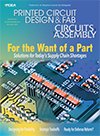Features Articles

At least five operation areas can benefit from switching from manual data entry.
"Innovation is the ability to see change as an opportunity, not a threat." – Steve Jobs
Several years ago, I embarked on an advanced engineering initiative, seeking unknown, innovative ways of processing PCB design packages for manufacturing external to the status quo, with a primary objective to drive efficiency and productivity, eliminating redundant data entry and reducing human interactions with their associated software applications. I had thrown in the towel relying on our software vendors to provide real and robust solutions. In my opinion, it was not in their interest. As their focus was selling more licenses to increase revenue, developing and marketing advanced automated solutions did not support this cause. My mantra was to take internal ownership and venture into unfamiliar territories. This path led me to OCR (optical character recognition) and, although skeptical at first, the results of our analysis were phenomenal.
Product design specifications and requirements are provided in formats such as PDF, Word, Excel, HPGL, or even as handwritten notes on scrap paper. A close associate of mine calls it “e-paper.” The variety of methodologies used to convey the same information across the PCB industry that is often ambiguous is staggering, to say the least. We print, read, interpret (hopefully correctly) and manually enter these data into our respective software application, often multiple times by multiple organizations.
To continue reading, please log in or register using the link in the upper right corner of the page.

Is round-the-clock engineering any way to live?
IDLENESS, n. A model farm where the devil experiments with seeds of new sins and promotes the growth of staple vices.
– Ambrose Bierce, The Devil’s Dictionary.
What makes a marketing expert a Marketing Expert?
What distinguishes a soft skill from a hard skill?
Is expertise conferred with an MBA at the tender age of 27? (How can somebody be considered a master of anything at 27?) Does wisdom come from meeting one’s quota nine reporting periods out of 10? Is it filling up spaces with arcane verbiage, hoping the reader is overwhelmed and won’t ask impertinent questions, like what does this all mean, and how does it benefit me?
To continue reading, please log in or register using the link in the upper right corner of the page.

Building functional test fixtures in-house mitigates several of the “seven wastes.”
The mantra of the electronics manufacturing services (EMS) industry has been faster, better, cheaper for four decades, given that outsourcing isn’t justifiable without a speed, quality or cost improvement over in-house processes. Continually delivering those benefits requires a focus on working smarter that relentlessly asks, “Where can we improve?”
Taiichi Ohno’s concept of the seven wastes (muda) in manufacturing as part of the Toyota Production System (TPS) provides a good thought process for evaluating any process. To recap, those seven wastes are:
- Waste of overproducing (no immediate need for product being produced)
- Waste of waiting (idle time between operations)
- Waste of transport (product moving more than necessary)
- Waste of processing (doing more than what is necessary)
- Waste of inventory (excess above what was required)
- Waste of motion (any motion not necessary outside of production)
- Waste of defects (producing defects requiring rework).
To continue reading, please log in or register using the link in the upper right corner of the page.

Plus, how AI can help deal with the threats.
Forget enterprise digital transformation. For better or worse, we are digitizing the world, and it’s changing everything. The opportunities to make things better are tremendous; we can save wasted energy and natural resources, democratize access to all kinds of services, improve standards of healthcare, prevent avoidable accidents, and accelerate our transition to renewable energy. By connecting everything, and introducing AI into the mix, we can gain insights we would otherwise never detect. Moreover, we can see the effects of our own behavior and use the analysis to identify ways to improve. Earlier technologies could never have done all this for us.
But there is always an “on the other hand,” and in this case the issues relate mostly to privacy and cybersecurity. We are putting more information about ourselves than ever before into the hands of data scientists. While we can expect better shopping experiences, we are at the same time disclosing insights into ourselves, our activities, and our preferences as individuals. And if we are not giving away information directly, everything we do online (and we are almost permanently online) reinforces the accuracy of any and every inference made by the AIs that constantly watch from the cloud.
To continue reading, please log in or register using the link in the upper right corner of the page.

How well does your incoming inspection team know the acceptability standards?
Does your PCB quality team inspect to pass or inspect to fail? Knowing the difference between what is rejectable in a printed circuit board and what is a nonissue is more important than ever.
Skyrocketing costs, shortages of copper and fiberglass materials, and longer delivery times mean remakes are not available as quickly as before. Rejecting PCBs for things that don’t affect the form, fit or function of the final project is simply bad business.
To be clear, I am not advocating acceptance of substandard product. IPC-A-600 standards are clear as to what is good and what is not. But thanks to lack of training or misinterpretation of industry specs, incoming PCB quality inspectors are turning away perfectly good commercial-grade boards that then must be remade.
The main culprit in this cycle of unnecessary PCB rejection and remake costs is management, which fails to provide adequate training to incoming inspectors and instills in them a fear of releasing bad product to the manufacturing floor.
To continue reading, please log in or register using the link in the upper right corner of the page.

The cycle of higher unemployment and prices must be broken.
I am not an economist, but having been around the block more than a few times over the past decades, it sure looks like financial déja vu!
My career started in the mid-1970s. At that time, the economic arena was swirling from extraordinary events that, together, created the perfect storm for hyperinflation. The aftermath of the US political crisis Watergate, staggering gas lines and shortages caused by the rolling Middle East oil embargos, and questionable Federal Reserve tactics led us to double-digit inflation. At that time, I was pricing administrator for a division of a global electronic connector manufacturer. Among my responsibilities was keeping the multi-thousand-part price book up to date. This task historically was done once every one or two years. In the environment we were in, however, I was updating prices two to three times each year!
It’s with this perspective I find myself trying to read the proverbial economic tea leaves of where we are headed in 2021 and beyond.
The past couple years, like in the mid-70s, have been filled with extraordinary events. Washington has been in gridlock; tariffs are finally resulting in shifts in where product is produced and shipped; a pandemic has displaced millions of workers and sent more home to work. Manufacturing facilities are reducing onsite staff, resulting in lower output and product shortages. Governments are responding with economic stimuli in the form of direct cash to citizens, enhanced unemployment benefits for those out of work, and low-cost loans to business and industry.
To continue reading, please log in or register using the link in the upper right corner of the page.


